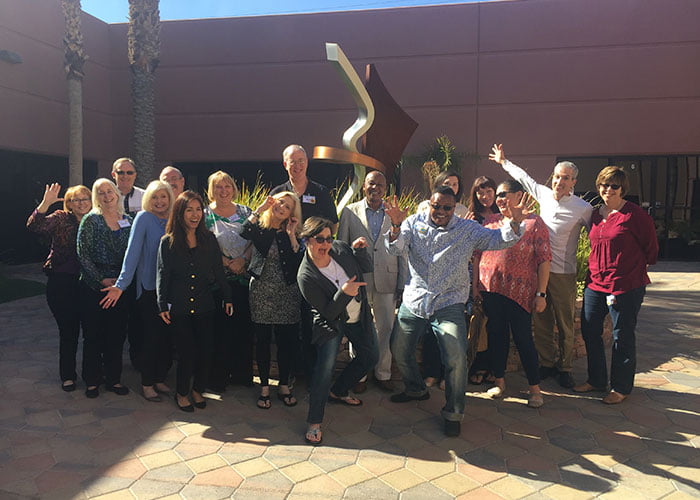Starting a meeting with Appreciative Inquiry sets the tone and gives participants an opportunity to sense into what’s possible.
Celebrating accomplishments by capturing them visually allows participants to see their successes before moving on to their next goals.
“Our Accomplishments” is a simple exercise and easy-to-draw template you can use in your next meeting to help participants see how far they have come and identify the root cause of their successes to strengthen their bond of working together as they move towards their next goals or projects.

“Our Accomplishments” chart from an annual staff/board retreat for a local arts center.
The image of the iceberg has been widely used for decades by many facilitators and change agents. Here we are using the iceberg metaphor as a way to focus the conversation in a way that we may:
- Celebrate our accomplishments.
- Identify our strengths and attributes of success.
- Build on our successes and recognize what we need in the future.
Purpose
To celebrate our accomplishments and identify our combined strengths and skills that make our team whole.
Process
Understand the desired outcomes of the meeting. In this case, the client identified that the organization was well positioned despite the pandemic but needed some emotional support as it transitioned opening back up and offering more programs.

Prior to the meeting…
We asked the Director to identify key accomplishments over the last few years. Knowing that one of the exercises would be to assess where the organization is according to Joan Gerry’s “14 Attributes of a Thriving Nonprofit,” we aligned the accomplishments to the 5 pillars and captured them inside of the top half of this iceberg.

During the meeting…
The Director set the tone by thanking everyone for attending the annual staff/board retreat and reflected on all that they accomplished during the pandemic. The facilitator then asked participants to add to the list of what they were proud of and that information was captured on the top half around the iceberg.

The facilitator then shifted the conversation by asking the question:
“Reflecting on the root cause of these successes, what attributes can you identify that contributed to your success?”
The attributes were then captured below the waterline inside of the iceberg. These represent the foundation of why the team was successful in positioning the organization for future success and that they can pull from this experience to take them where they want to go next.

While wrapping up the meeting, participants reflected on all they accomplished in their short time together. The facilitator brought the image to the forefront again to remind them of their strengths as they took on the next steps of the three strategic goals they set in the retreat.

Payoff
Celebrating successes allows teams to reflect on their efforts, rejuvenate their spirit (their WHY), and learn what’s working so they may bring it with them to apply to future projects.
Identifying the attributes that led to their successes shines a light on their strengths as a foundation from which they may strategize and grow.
Principles used in this exercise:
Constructionist, Simultaneity, Poetic, Positive, Wholeness, Narrative, and Awareness
Supplies:
- Pinboard or large paper on a roll
- Markers
Instructions for prepping the template:
- Gather the supplies and accomplishments to pre-populate the template.
- Draw the outline of the iceberg. Let it take up 1/2-3/4 of the space to allow space to write inside and around the outside of the iceberg. PRO TIP: Words first, then draw the container. Draw the iceberg shape with a pencil, write the accomplishments in marker inside the pencil line then draw the shape around the words.
- Draw the waterline just below the accomplishments.
Optional: want to give the exercise some added “Umfph!”? Use the Learn Lead Lift Framework™ by Wendy Ryan to identify the Mindsets, Skill sets, and Behaviors the team has and can aspire to develop as a way to develop leaders at all levels of the organization.
Resources:
Appreciative Inquiry Principles
https://centerforappreciativeinquiry.net/more-on-ai/principles-of-appreciative-inquiry/
Learn Lead Lift: How to Think, Act and Inspire Your Way to Greatness
https://www.learnleadlift.com/
AI + Visuals: Meeting Design
Part One, Free mini-session: https://centerforappreciativeinquiry.net/event/appreciative-inquiry-visuals-free-mini-session-oct-2022/
Part Two, 3-week course: https://centerforappreciativeinquiry.net/event/appreciative-inquiry-visuals-meeting-design-nov-2022/
Heather Leavitt Martinez uses Appreciative Inquiry in all of her work—from meeting approach design, facilitating and coaching, to living out the principles in her everyday life. She teaches relevant, timely techniques to apply AI to tech hosting at www.TechHostAcademy.com and combines it with visuals in her course: “AI + Visuals: Meeting Approach Design” at the Center of Appreciative Inquiry.


Add your comment now using your favorite social account or Click Here To Login
